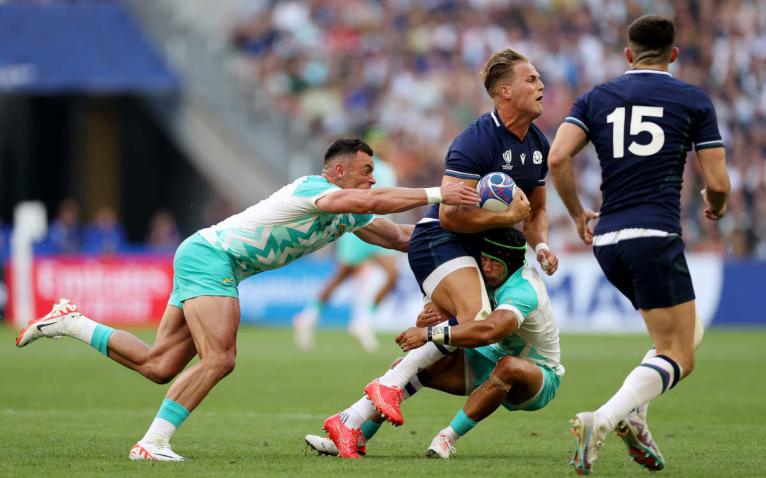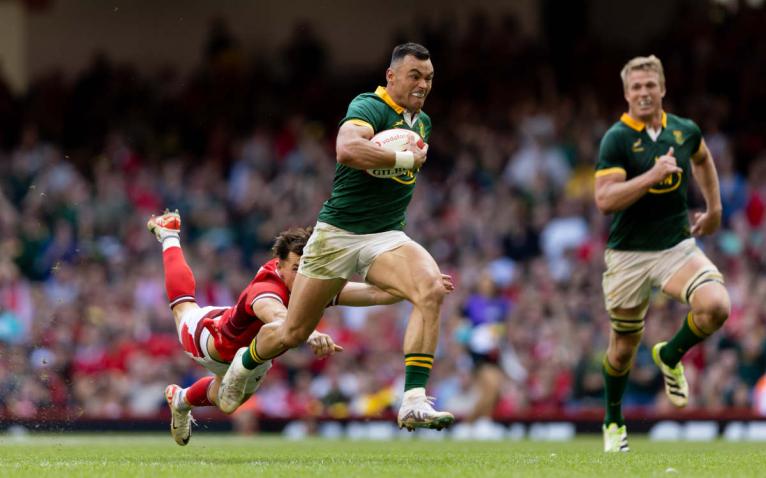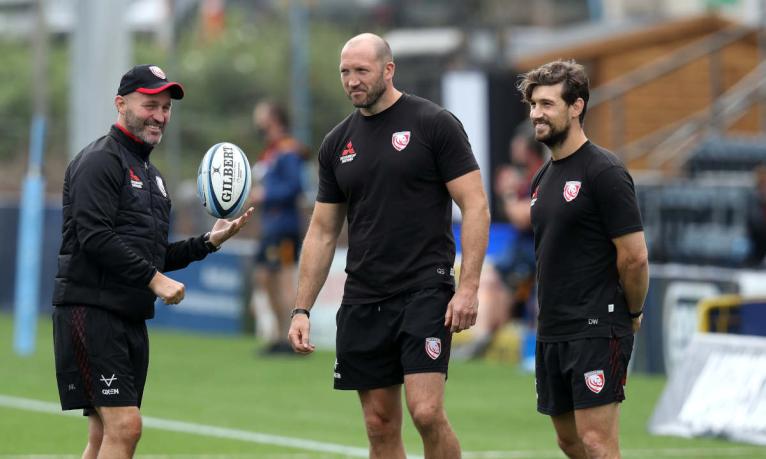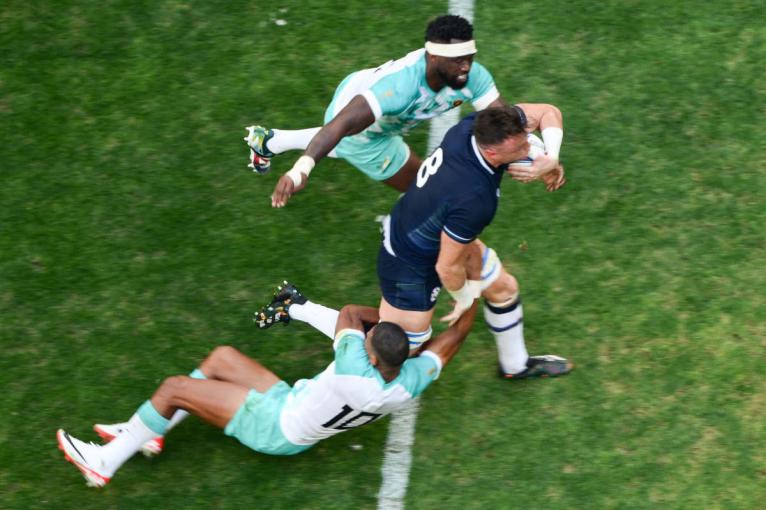It comes at you like a storm. A furious swirl of muscle and bone and bad intentions. There’s no time to think, no time to breathe. Everyone is running on pure instinct. When it works, it’s the most devastating defensive tactic in rugby. But the margins are razor-thin. One misstep and your fortification is breached. Some call it a blitz, evoking images of rubble and ruin. It’s more commonly known as the rush. Whatever nomenclature you choose, it’s best observed from a safe distance.
“It’s one of the most difficult things to pull off,” says Dominic Waldouck, Gloucester’s defence coach who played under the strategy’s godfather, Shaun Edwards, at Wasps for four years in the 2010s. “Shaun used to say all the time, ‘It’s high risk, high reward’. Not many teams can get it right.”
It’s so difficult, in fact, that Waldouck no longer runs a rush defence at Gloucester. “We’d leave too many holes and we found we were leaking tries,” he explains. Even at the elite level there is a large degree of danger. One team, however, has made the strategy a cornerstone of their World Cup campaign. Come Saturday, we’ll see if it works.
The Springboks are now synonymous with the rush defence. This weekend they’ll put it to the test against Ireland, arguably the most cohesive and well drilled attacking sides in the game. Keeping Johnny Sexton, Bundee Aki and company in check will require a monumental effort from the collective. But one man in particular will play a leading role.

“The 13 is the most important player when you’re setting up for a rush,” explains Waldouck, who spent his career alternating between the two centre positions. “It’s the most difficult position to defend because you’ve got runners on your inside and your outside. If you make a mistake your entire line is broken. So you’re the guy that has to make that first press and then the rest follow. Jesse Kriel for South Africa knows what he’s doing.”
Kriel began his professional career as a winger with the Blue Bulls in 2013 and was occasionally used as a fullback. A supremely gifted athlete with great positional awareness, his raw pace and power naturally saw him shifted to the wider positions.
Midfield was always his natural home. It’s where he played for the South African under-20s in two consecutive World Cups. And when he made his senior debut in the 2015 Rugby Championship against Australia in Brisbane, he started with 13 on his back.
Players are often judged by their predecessors and the spectre of Jaque Fourie was a constant presence as Kriel never quite had the same gainline dominance or finishing prowess. And when Lukhanyo Am entered the scene in 2017, Kriel’s limitations became starkly evident. He lacked Am’s grace and touch. He appeared to move along right angles and brutish straight lines while Am flowed like an unraveling silk reel.
Whenever Kriel starts for the Springboks, the team concedes less line-breaks, makes more tackles, concedes less entries into their own 22, concedes less points per the opposition’s entry into their 22 and they win more turnovers.
These comparisons calcified into a critical public perception but the narrative missed a crucial component of Kriel’s game. It’s one that has always been important to his team’s overall plan and is now more so than ever. He might not play behind-the-back off-loads or unleash runners on his outside with jaw-dropping passes, but, as the stats reveal, he is a defensive general.
Over the past two years, only three players – Tom Curry, Marika Koroibete and Mack Hansen – have a higher tackle dominance percentage than Kriel’s 15.9% in Test rugby. Whenever Kriel starts for the Springboks, the team concedes less line-breaks, makes more tackles, concedes less entries into their own 22, concedes less points per the opposition’s entry into their 22 and they win more turnovers, a consequence of their tackle dominance and ability to isolate ball carriers.

His own stats don’t necessarily jump off the page. Nor does he produce blockbuster highlights reels. But if you watch his game live, you’ll notice a few things that the TV cameras don’t pick up.
He’s conspicuously the most vocal player on defence. His arms never stop moving as he pulls teammates into position and provides instruction on when to press. He’s not necessarily the one making the tackle. He’s almost never the one cleaning up once the hit has been made. Instead he serves as the sheep dog in the Springboks’ line.
Communication is one of the most important ingredients in the rush defence. It’s so easy to become disconnected. Because you’re all moving so quickly the key thing is to remain tight.
Dominic Waldouck
“Communication is one of the most important ingredients in the rush defence,” Waldouck adds. “It’s so easy to become disconnected. Because you’re all moving so quickly the key thing is to remain tight. If you go too early or too late, or if the guy next to you isn’t in sync, you’re done.
“Shaun [Edwards – who has revolutionised the French defence since he joined Fabian Galthie’s team in 2020] used to keep things very simple. He had this mantra called, ‘Zoom-Cruise-Zoom’. Basically we’d zoom as fast as we could when the ball was in the air. Then if the ball carrier was out of reach we’d just take a beat and settle our feet before zooming again once he passed or ran. The simpler you can make it, the better it will work.”
Cohesion, though, is just one core ingredient of a successful rush defence. According to Waldouck, centres and wingers need to watch the ball carefully and not get sucked into false movements by decoy runners or players on the wraparound.

That last bit is key. One of Ireland’s most successful attacking plays involves Sexton drifting round the back of a strong carrier before collecting the ball again and feeding a runner on the angle. It even has its own name – the Sexton-Loop – and is a proven way of working through a rush defence.
This pattern relies on quick ball out the back of the ruck. Holes are created in the defensive line when players have little time to get into position. Which is why a successful rush also relies on the big units up front.
“You need a fit and aggressive tight five to make it work,” Waldouck says. “You need to be dominant in those close quarter collisions and you need to wear down the opposition with mauls and scrums.
“You also need to slow down the ball at the ruck so intensity at the breakdown with fetchers targeting the ball is key. The more time you can give your backline to set before rushing, the more chance they have of hitting the ball carrier as he receives the ball. That’s the aim. Because you’re moving at such high speeds, if you’re a fraction late the opposition player can easily step you. In order to get line speed, you need width. And in order to get width, you need to slow the ball down.”
South Africa have named a 7-1 split between forwards and backs on the bench, just as they did against New Zealand in a crushing 35-7 win last month. Back then the Springboks brought all their replacements on at once, leaving Pieter-Steph du Toit as the only unchanged member of the pack.
Much has been made of this tactic. Some Irish pundits have been foaming at the mouth, accusing South Africa of devilry and deceit. Much of the angst has focussed on the immense size of the Boks’ big hitters but there has been little mention of the three fetchers who will enter the fray around the hour mark.

“The message will be, ‘empty the tank, boys’,” Waldouck says with an uplift in his voice. “I can’t wait to see how it goes. It’s the best attack against the best defence. I’ll be keeping an eye on Kriel. If he goes well, the rest will follow.”
Still in his 20s, Kriel has plenty of rugby to play before he calls it quits. When he does eventually hang up the boots, he might consider a career on the training pitch. It’s worked for Waldouck, who explains that outside centres are ideal defence coaches.
“Becuase you’ve been in those challenging situations, you know how to challenge others,” he says. “Coming up with those solutions is part of the fun. It’s a high octane place. It’s full of energy. The rush defence creates big moments, big hits. When it works, there’s nothing better.”


Kriel is excellent at what they are asking him to do. You don't get highlight reels for defensive organization, or slo-mo replays of an attacking team getting nothing useful done.
The Boks have conceded zero tries, and have played much more challenging opposition than Ireland has. If SA can keep that kind of defence going then it won't take much more to win the RWC.
And Kriel is an important piece of that, as Daniel Gallan is pointing out.
Makes for a good read about the roll the outside center does, like he says best attack against the best defence going to be an epic game, Go Bokke.
The only Irish pundit giving out about the 7-1 is Keith Wood and even then he’s being consistent with his views on there being too many subs as he played back when there was less subs and it wasn’t a tactical aspect of the game.